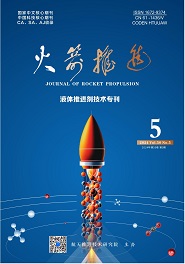航天推进技术研究院主办
LI Jian,AN Yang,SHI Wenjing.Effect of booster separation on operating characteristics of oxygen pump by simulation test[J].Journal of Rocket Propulsion,2020,46(03):49-55.
助推分离对氧泵工作特性影响的模拟试验
- Title:
- Effect of booster separation on operating characteristics of oxygen pump by simulation test
- 文章编号:
- 1672-9374(2020)03-0049-07
- Keywords:
- booster separation; hydrogen/oxygen rocket engine; ground hot-fire test; oxygen pump; cavitation; engine performance
- 分类号:
- V434.3
- 文献标志码:
- A
- 摘要:
- 为了研究火箭助推分离过程中,芯级液体火箭发动机氧泵入口压力快速下降对氧泵的工作特性和发动机工作性能的影响,在氢氧火箭发动机整机试车中,通过控制氧泵入口压力的方式,使氧泵逐步进入气蚀状态,开展了发动机整机状态下的氧泵气蚀研究试验,获得了氧泵气蚀状态下氧泵参数变化情况,考核了发动机经过短暂气蚀的工作特性。试验结果表明,转速升高约1 800 r/min的气蚀程度,会造成氧泵流量下降7.14%,氧泵效率下降11.82%,氧泵轴向振动幅值增大约90%。氧泵在经历时间约7 s的短暂气蚀状态后,氧泵性能无明显变化,不影响发动机工作性能
- Abstract:
- During the process of booster separating from the rocket, the rapid drop of the oxygen pump inlet pressure affects its operating characteristics and the engine performance. In order to study this question, the oxygen pump was gradually brought into a cavitation state by controlling the inlet pressure of oxygen pump in the ground hot-fire test. The cavitation test of the oxygen pump under the overall test condition was carried out, and the parameters of the oxygen pump in the cavitation state were obtained. The engine performance after a brief cavitation was evaluated. The test results show that when the cavitation occurs in the oxygen pump with the rotation rate increasing 1 800 r/min, the flow rate of oxygen pump is decreased by 7.14%, the efficiency of oxygen pump is decreased by 11.82%, and the axial vibration of oxygen pump is increased by 90% approximately. After a short cavitation state of about 7 seconds, the performance of oxygen pump has no obvious change, which does not affect the engine performance
参考文献/References:
[1] 刘国球.液体火箭发动机原理[M].北京:中国宇航出版社,1993.
[2]潘中永, 袁寿其. 泵空化基础[M]. 镇江: 江苏大学出版社, 2013.
[3] 朱宁昌.液体火箭发动机设计[M].北京:中国宇航出版社,1994.
[4] BRENNEN C E. Cavitation and bubble dynamics[M]. Oxford:Oxford University Press,1995.
[5] KIM D J, SUNG H J, CHOI C H, et al. Cavitation instabilities during the development testing of a liquid oxygen pump[J]. Journal of Propulsion and Power, 2017, 33(1): 187-192.
[6] 关醒凡. 现代泵理论与设计[M]. 北京: 中国宇航出版社, 2011.
[7] 杰克布森J K.液体火箭发动机涡轮泵诱导轮 [M].傅轶青,陈炳贵,译.北京:国防工业出版社,1971.
[8] 陈泰然, 顾玲燕, 王国玉, 等. RP-3航空煤油不同替代模型的空化流动特性[J]. 推进技术, 2016, 37(3): 563-571.
[9] 姜映福, 刘中祥, 褚宝鑫. 低温流体汽蚀的数值计算及可视化实验研究[J]. 推进技术, 2017, 38(12): 2771-2777.
[10] YOSHIDA Y, SASAO Y, OKITA K, et al. Influence of thermodynamic effect on synchronous rotating cavitation[J]. Journal of Fluids Engineering, 2007, 129(7): 871-876.
[11] 李龙贤, 丁振晓, 吴玉珍. 基于热力学效应修正的诱导轮空化模型研究[J]. 火箭推进, 2019, 45(5): 52-58.
LI L X, DING Z X, WU Y Z. Research on cryogenicinducer cavitation model modified by thermodynamic effect[J]. Journal of Rocket Propulsion, 2019, 45(5): 52-58.
[12] STINEBRING D R, ARNDT R E A, HOLL J W. Scaling of cavitation damage[J]. Journal of Hydronautics, 1977, 11(3): 67-73.
[13] REBOUD J, POUFFARY B. Numerical simulation of unsteady cavitation flows: some applications and open problems[C]//Fifth International Symposium on Cavitation. Osaka:[s.n.], 2003.
[14] KELLY S, SEGAL C, PEUGEOT J. Simulation of cryogenics cavitation[J]. AIAA Journal, 2011, 49(11): 2502-2510.
[15] BROPHY M C, STINEBRING D R, BILLET M L. An analysis of pump cavitation damage[J]. Journal of Propulsion and Power, 1985, 1(6): 441-448.
[16] 庄建, 李琪琪, 王智超. 火箭发动机试验紧急关机过程分析与改进[J]. 火箭推进, 2017, 43(2): 40-46.
ZHUANG J, LI Q Q, WANG Z C. Analysis and improvement of emergency shutdown process in rocket engine test[J]. Journal of Rocket Propulsion, 2017, 43(2): 40-46.
[17] 赵万明,史超,唐云龙.发动机起动加速性计算参数相应热性[J].火箭推进,2019,45(5):96-102.
ZHAO W M, SHI C, TANG Y L. The parameter response characteristic of starting acceleration of rocket engine[J]. Journal of Rocket Propulsion,2019,45(5):96-102.
[18] 郭霄峰.液体火箭发动机试验[M].北京:中国宇航出版社,1990.
相似文献/References:
[1]张小通,李 茂,张家仙,等.氢氧火箭发动机高模试验富氧蒸汽引射仿真[J].火箭推进,2023,49(02):100.
ZHANG Xiaotong,LI Mao,ZHANG Jiaxian,et al.Simulation of oxygen-rich steam ejection in high altitude simulation test for hydrogen/oxygen rocket engine[J].Journal of Rocket Propulsion,2023,49(03):100.
备注/Memo
收稿日期:2019-11-20; 修回日期:2019-12-26
基金项目:国家装备预研航天科技联合基金(6141B06260403)
作者简介:李建(1988—),男,硕士,工程师,研究领域为液体火箭发动机系统设计
